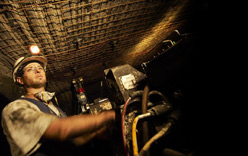VENTILATION
Main Fans
Note that the following is written using fan in the
singular for the main ventilation. In fact where a large fan duty is required
it is common to use 2 or 3 fans in parallel to provide the duty. The reasons
for this are:
- Fan duties are becoming very large and the
physical size of fans that could meet such duties singularly become
impractical
- With multiple fans partial ventilation can
be maintained in the event that one is stopped, a feature which is considered
very beneficial.
The main fans which ventilate large mines are major
power consumers, having large motors which run virtually continuously, usually
only being stopped for maintenance purposes. Great care is therefore required
in design and specification in order to avoid unnecessary expenditure. The fan
duty required often varies greatly over the life of a mine as the workings
become more extensive and it is usually best to make provision for varying the
fan performance. This can be done by installing inlet vanes, which restrict the
fan inlet size, or by varying the fan speed. Speed can be varied by changing motors,
by use of gears or by use of variable drive systems (VVVF drives are being
increasingly used).
Air quantity flowing at the main fan is large and
unless care is taken with the design of airways and ducting considerable power
can be wasted in overcoming the resistance and shock losses which result.
Airways should be as straight and smooth as possible and sudden changes of
direction should be avoided as far as practical. At the same time there is a
requirement that provision be made to protect main fans from damage in the
event of an explosion. This is done by mounting the fans away from the direct
line of the main airway, which usually involves a 90o deflection (or
close to it), and providing a device in line with the airway that is designed
to fail under pressure and release the explosion pressure (e.g.doors or a weak
section of duct).
Airways should be kept as clear as possible, though it
is common for main return shafts to involve winders with the associated shaft
fittings.
High air flows in shafts can cause problems:
- Because of the effect of turbulence on
stability of cages, counterweights or ropes
- If shafts are wet high velocities can
result in water being held in suspension causing unstable flow (air velocities
between 8 and 12 m/s should be avoided; above this range water will be carried
up the shaft and will have to be dealt with at the fan site and part of the fan
power cost will actually be for pumping water).
As fan duties become more onerous, the ability to
provide ventilation using only fans on the surface becomes increasingly
difficult, especially for mines with coal liable to spontaneous combustion. The
use of "booster fans"
sited underground and acting in series with the surface fan will become more
common. While such strategies may be preferred they raise difficulties in
relation to interlocking surface and underground fans, avoiding recirculation
and separately ventilating underground fan motors to ensure gas-laden air does
not pass over the motor(s).

